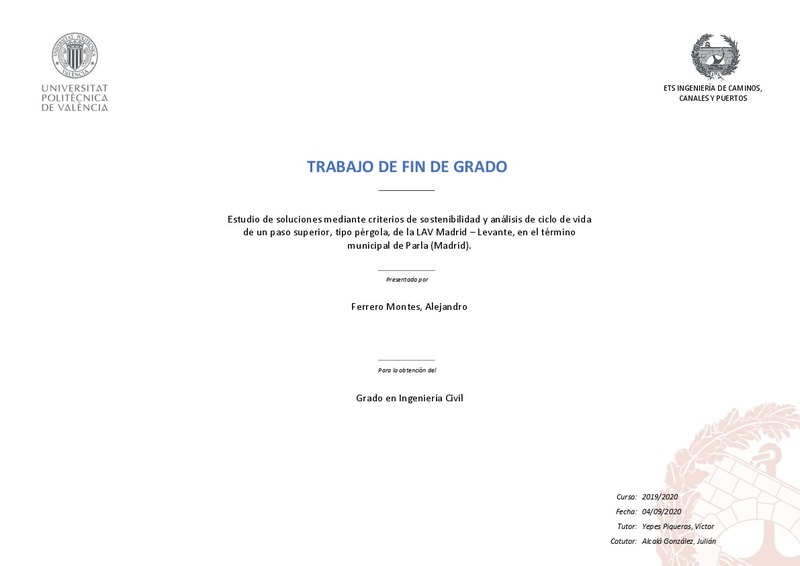JavaScript is disabled for your browser. Some features of this site may not work without it.
Buscar en RiuNet
Listar
Mi cuenta
Estadísticas
Ayuda RiuNet
Admin. UPV
Estudio de soluciones mediante criterios de sostenibilidad y análisis del ciclo de vida de un paso superior, tipo pérgola, de la LAV Madrid-Levante, en el término municipal de Parla (Madrid)
Mostrar el registro sencillo del ítem
Ficheros en el ítem
| dc.contributor.advisor | Yepes Piqueras, Víctor
|
es_ES |
| dc.contributor.advisor | Alcalá González, Julián
|
es_ES |
| dc.contributor.author | Ferrero Montes, Alejandro
|
es_ES |
| dc.coverage.spatial | east=-3.768906; north=40.232367; name=Plaza Tierno Galván, 32, 28982 Parla, Madrid, Espanya | es_ES |
| dc.date.accessioned | 2021-05-31T09:03:44Z | |
| dc.date.available | 2021-05-31T09:03:44Z | |
| dc.date.created | 2020-09-17 | |
| dc.date.issued | 2021-05-31 | es_ES |
| dc.identifier.uri | http://hdl.handle.net/10251/166981 | |
| dc.description.abstract | [ES] El transporte es un factor principal en el consumo de energía y emisiones contaminantes a nivel global. Se suele fomentar la utilización del uso del ferrocarril como medio de transporte, ya que, debido a su eficiencia, permite minimizar dicho impacto global. Por contraposición, la implementación del ferrocarril como medio de transporte requiere la construcción de importantes infraestructuras, cuya ejecución causa grandes impactos. Se pretende reducirlos planteando un estudio de soluciones mediante el uso de técnicas multicriterio, que considere la economía, el medio ambiente y la sociedad, para pasos superiores de ferrocarril tipo pérgola. Se emplea la metodología del análisis del ciclo de vida completo, evaluando las fases que lo conforman, es decir, la construcción y el mantenimiento de las alternativas consideradas. Se ha llevado a la práctica en un paso superior tipo pérgola que pertenece a la línea de alta velocidad que une Madrid con Levante, concretamente ubicado en Parla (Madrid). Se evalúa la implementación de tres soluciones distintas de pérgola, seleccionando una primera solución totalmente prefabricada, otra totalmente de ejecución insitu y por último, una mixta entre las dos anteriores. La finalidad es seleccionar la solución más adecuada, teniendo en cuenta la evaluación de los tres factores mencionados. | es_ES |
| dc.description.abstract | [EN] Transport is a major factor in global energy consumption and pollutant emissions. The efficienty of the rail as a mean of transport contributes to minimize this overall impact and therefore its usage has oftten been encouraged. On the other hand, the implementation of the railway requires the construction of important infrastructures and their execution may cause great impacts. The aim of this project is to analyse feasible solutions to reduce them through the use of multicriteria techniques, which consider the economy, the environment and society, for higher pergola railway passes. The methodology for the analysis of the complete life cycle has been used, evaluating the phases that constitute it. Those phases are the construction and maintenance of the alternatives considered. It has been implemented in an overpass with pergola structure that belongs to the high-speed line between Madrid and Levante, specifically located in Parla (Madrid). The implementation of three different pergola solutions has been evaluated, selecting at first a fully prefabricated solution, then another fully in-situ execution solution and finally, a mixed one between the two previous ones. The objective of the analysis is to select the most appropriate solution, taking into account the evaluation of the three factors aforementioned. | es_ES |
| dc.format.extent | 186 | es_ES |
| dc.language | Español | es_ES |
| dc.publisher | Universitat Politècnica de València | es_ES |
| dc.rights | Reserva de todos los derechos | es_ES |
| dc.subject | Sostenibilidad | es_ES |
| dc.subject | Ciclo de vida | es_ES |
| dc.subject | Análisis multicriterio | es_ES |
| dc.subject | Ferrocarril | es_ES |
| dc.subject | Alta velocidad | es_ES |
| dc.subject | Puente | es_ES |
| dc.subject | Sustainability | es_ES |
| dc.subject | Life Cycle | es_ES |
| dc.subject | Multicriteria analysis | es_ES |
| dc.subject | Railway | es_ES |
| dc.subject | High speed | es_ES |
| dc.subject | Bridge | es_ES |
| dc.subject.classification | INGENIERIA DE LA CONSTRUCCION | es_ES |
| dc.subject.other | Grado en Ingeniería Civil-Grau en Enginyeria Civil | es_ES |
| dc.title | Estudio de soluciones mediante criterios de sostenibilidad y análisis del ciclo de vida de un paso superior, tipo pérgola, de la LAV Madrid-Levante, en el término municipal de Parla (Madrid) | es_ES |
| dc.type | Proyecto/Trabajo fin de carrera/grado | es_ES |
| dc.rights.accessRights | Abierto | es_ES |
| dc.contributor.affiliation | Universitat Politècnica de València. Escuela Técnica Superior de Ingenieros de Caminos, Canales y Puertos - Escola Tècnica Superior d'Enginyers de Camins, Canals i Ports | es_ES |
| dc.contributor.affiliation | Universitat Politècnica de València. Departamento de Ingeniería de la Construcción y de Proyectos de Ingeniería Civil - Departament d'Enginyeria de la Construcció i de Projectes d'Enginyeria Civil | es_ES |
| dc.contributor.affiliation | Universitat Politècnica de València. Instituto de Ciencia y Tecnología del Hormigón - Institut de Ciència i Tecnologia del Formigó | es_ES |
| dc.description.bibliographicCitation | Ferrero Montes, A. (2020). Estudio de soluciones mediante criterios de sostenibilidad y análisis del ciclo de vida de un paso superior, tipo pérgola, de la LAV Madrid-Levante, en el término municipal de Parla (Madrid). Universitat Politècnica de València. http://hdl.handle.net/10251/166981 | es_ES |
| dc.description.accrualMethod | TFGM | es_ES |
| dc.relation.pasarela | TFGM\125964 | es_ES |
Este ítem aparece en la(s) siguiente(s) colección(ones)
-
ETSICCP - Trabajos académicos [2365]
Escuela Técnica Superior de Ingenieros de Caminos, Canales y Puertos




![ZIP archive [ZIP]](/themes/UPV/images/zip.png)


